

Bloomin' Apps. This page gathers all of the Bloomin' Apps projects in one place.Each image has clickable hotspots and includes suggestions for iPad, Android, Google and online tools and applications to support each of the levels of Bloom's Revised Taxonomy.I have created a page to allow you to share your favorite online tool, iOS, or Android app with others.
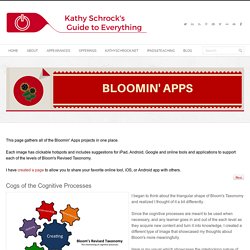
Cogs of the Cognitive Processes. European Section. Home - The Teacher Toolkit. The 5 Minute Marking Plan by @TeacherToolkit and @LeadingLearner #5MinPlan. Marking is an occupational hazard for all teachers.
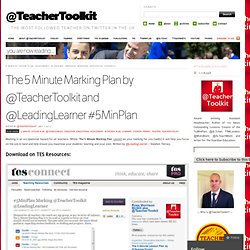
Whilst ‘The 5 Minute Marking Plan’ cannot do your marking for you (sadly) it will help you focus on the job in hand and help ensure you maximise your students’ learning and your own. Written by @LeadingLearner – Stephen Tierney. Download on TES Resources: Click to download the template. Teachinghistory.org. Teaching Adolescents How to Evaluate the Quality of Online Information.
An essential part of online research is the ability to critically evaluate information. This includes the ability to assess its level of accuracy, reliability, and bias. In 2012, my colleagues and I assessed 770 seventh graders in two states to study these areas, and the results definitely got our attention. Unfortunately, over 70 percent of the students’ responses suggested that: Middle school students are more concerned with content relevance than with credibility They rarely attend to source features such as author, venue, or publication type to evaluate reliability and author perspective When they do refer to source features in their explanations, their judgments are often vague, superficial, and lacking in reasoned justification Other studies highlight similar shortcomings of high school and college students in these areas (see, for example, a 2016 study from Stanford).
The Best Resources On Differentiating Instruction. My colleague Katie Hull-Sypnieski is leading a February 1st Education Week Webinar on differentiating instruction, and I would strongly encourage people to participate.

Katie’s the best teacher I’ve ever seen…. In addition, Katie and I have co-authored a piece for Education Week Teacher on the topic that will be appearing there soon (it’s appeared: The Five By Five Approach To Differentiation Success), and an upcoming post in my blog there will be talking about it, too (that two part series has also appeared). I also did a second two-part series in Ed Week on differentiation. Also, check out The Best “Fair Isn’t Equal” Visualizations.
Given all that, a “The Best…” post was inevitable, and here it is. Teachinghistory.org. Tools of the Historian. Bloom’s Taxonomy: The 21st Century Version. Bloomin' Apps. Pimp my Classroom: 8 ways to confuse the cleaner. I posted this image on Twitter a while ago of when I made an entrance into my classroom out of an enlarged essay.

I used the slice tool on Photoshop, printed A3 in B/W and then, aided by two students, pieced it back together. St. Peter's School Teaching & Learning Research & Development. CPD Briefing #9: Comments, on comments The CPD Briefing for this week was handed over to staff, in department teams, to revisit input to date from our Thursday morning sessions.

Since November nearly all of the 20 minute sessions -delivered by more than 30 different staff-… Read more › Revision: 20 top tips from the bedroom in the dining hall. Motivating Teens with Mobile Devices. Design Thinking in the Classroom: Free Inspiration from the Ad Award Winners. "For students, the best classroom experience is a space of possibility.

" - Anne Stevens1 Design thinking can transform your classroom into a space of creativity, excitement and possibility. The design thinking process involves rethinking and reframing problems to make things easier, more streamlined or different. Jackie Gerstein attests that design thinking is an important skill for students to learn as part of their education.2 What Is Design Thinking? Design thinking is a structured approach to solving problems. Lifelong Learning. AUTODIDACTIC PRESS - lifelong learning advocate, Charles D. Hayes. Accelerated Learning. The 33 Digital Skills Every 21st Century Teacher should Have. By EdTech Team Updated on march 2, 2015 : The original list that was created in 2011 comprised 33 skills , after reviewing it we decided to do some merging and finally ended up with the 20 skills below.
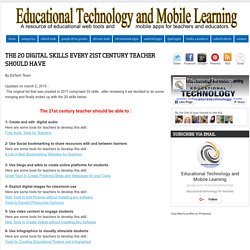
The 21st century teacher should be able to : 1- Create and edit digital audio Here are some tools for teachers to develop this skill :Free Audio Tools for Teachers. Sugata Mitra's 5 favorite education talks. TED. Big Thinkers on Education. Rethinking education in the age of technology.pdf. The 21st century pedagogy teachers should be aware of. Interpersonal learning , personalized learning, second life learning , 3d learning, collaborative learning and virtual learning , these are just some of the few buzz words you would be be reading so often in today’s educational literature.

Things have changed , old methods and pedagogies are no longer relevant. The teacher-controlled learning where pre-constructed information is presented in a formal and standardized classroom settings becomes very obsolete. The urgent questions we should , as educators , ask ourselves are : what are the driving factors behind this huge transformation in learning ? And Do we need a new pedagogy to better enhance learning ? Advancements in technology and particularly social networking technologies are changing the whole educational framework . It is evident now that we are in front of two different versions of learner one is labeleed the the 20th century learning and the second is called the 21st century learning. 20th century and 21st century teachers.
How To Think & Learn... How it's done - Building Learning Power. BLP has a clear social, moral and philosophical rationale.
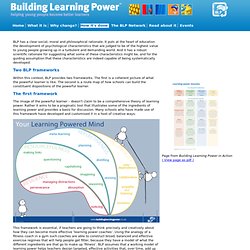
What it is - Building Learning Power. Building Learning Power has one big ambition, based on three core beliefs, nurtured by three root systems, leading to a revolution in learning.
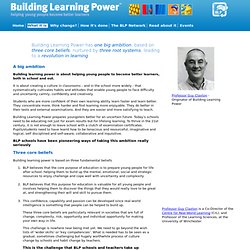
A big ambition Building learning power is about helping young people to become better learners, both in school and out. It's not 1989. I saw this online the other day. Flipping The Classroom… A Goldmine of Research and Resources To Keep You On Your Feet. Greetings from Boston and BLC12 (Alan November’s Building Learning Communities Conference ). If you wish to follow the happenings at BLC12 check out the hashtag #BLC12 on Twitter. Welcome to another post rich in resources on the Flipped Classroom.
If you have come here looking for links that will guide you to videos and multimedia to use in a Flipped Classroom you will find that in the second half of this post. Perhaps you have tried a little Flip of your own and want to learn more. If you are beginning to investigate what a Flipped Classroom is, with the thought of possibly trying some kind of Flip yourself… then this is also the right place. Apps for Multiple Intelligences. A-Z - School of Education Communication and Language Sciences. Introduction I am interested in self organising systems, particularly for primary education.
Background Prof. Sugata Mitra is Professor of Educational Technology at the School of Education, Communication and Language Sciences at Newcastle University, UK. Bloom’s Taxonomy: The 21st Century Version. Sugata Mitra: The child-driven education.